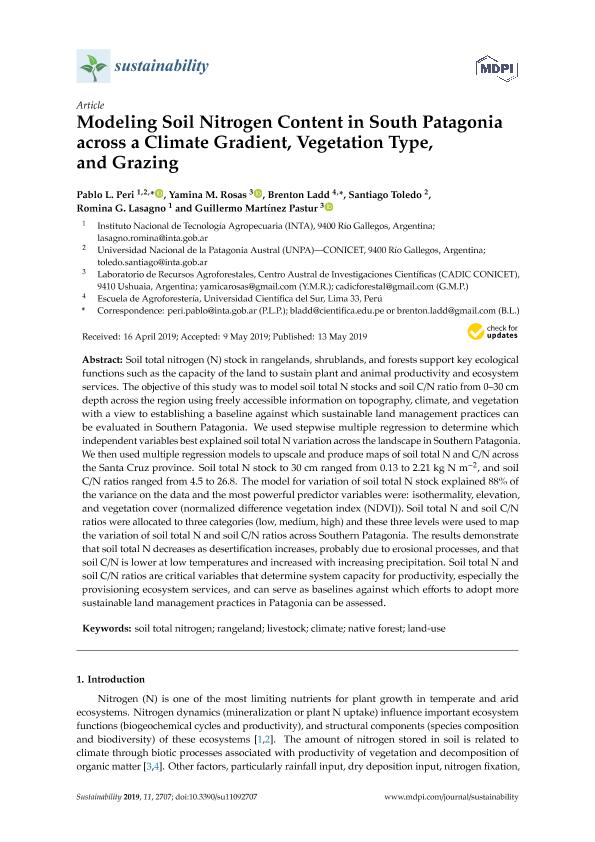Artículo
Modeling Soil Nitrogen Content in South Patagonia across a Climate Gradient, Vegetation Type, and Grazing
Peri, Pablo Luis ; Rosas, Yamina Micaela
; Rosas, Yamina Micaela ; Ladd, Brenton; Toledo, Santiago
; Ladd, Brenton; Toledo, Santiago ; Lasagno, Romina G.; Martínez Pastur, Guillermo José
; Lasagno, Romina G.; Martínez Pastur, Guillermo José
 ; Rosas, Yamina Micaela
; Rosas, Yamina Micaela ; Ladd, Brenton; Toledo, Santiago
; Ladd, Brenton; Toledo, Santiago ; Lasagno, Romina G.; Martínez Pastur, Guillermo José
; Lasagno, Romina G.; Martínez Pastur, Guillermo José
Fecha de publicación:
05/2019
Editorial:
MDPI AG
Revista:
Sustainability
ISSN:
2071-1050
Idioma:
Inglés
Tipo de recurso:
Artículo publicado
Clasificación temática:
Resumen
Soil total nitrogen (N) stock in rangelands, shrublands, and forests support key ecological functions such as the capacity of the land to sustain plant and animal productivity and ecosystem services. The objective of this study was to model soil total N stocks and soil C/N ratio from 0-30 cm depth across the region using freely accessible information on topography, climate, and vegetation with a view to establishing a baseline against which sustainable land management practices can be evaluated in Southern Patagonia. We used stepwise multiple regression to determine which independent variables best explained soil totalNvariation across the landscape in Southern Patagonia. We then used multiple regression models to upscale and produce maps of soil total N and C/N across the Santa Cruz province. Soil total N stock to 30 cm ranged from 0.13 to 2.21 kg N m-2, and soil C/N ratios ranged from 4.5 to 26.8. The model for variation of soil total N stock explained 88% of the variance on the data and the most powerful predictor variables were: isothermality, elevation, and vegetation cover (normalized difference vegetation index (NDVI)). Soil total N and soil C/N ratios were allocated to three categories (low, medium, high) and these three levels were used to map the variation of soil total N and soil C/N ratios across Southern Patagonia. The results demonstrate that soil total N decreases as desertification increases, probably due to erosional processes, and that soil C/N is lower at low temperatures and increased with increasing precipitation. Soil total N and soil C/N ratios are critical variables that determine system capacity for productivity, especially the provisioning ecosystem services, and can serve as baselines against which efforts to adopt more sustainable land management practices in Patagonia can be assessed.
Palabras clave:
CLIMATE
,
LAND-USE
,
LIVESTOCK
,
NATIVE FOREST
,
RANGELAND
,
SOIL TOTAL NITROGEN
Archivos asociados
Licencia
Identificadores
Colecciones
Articulos(CADIC)
Articulos de CENTRO AUSTRAL DE INVESTIGACIONES CIENTIFICAS
Articulos de CENTRO AUSTRAL DE INVESTIGACIONES CIENTIFICAS
Articulos(SEDE CENTRAL)
Articulos de SEDE CENTRAL
Articulos de SEDE CENTRAL
Citación
Peri, Pablo Luis; Rosas, Yamina Micaela; Ladd, Brenton; Toledo, Santiago; Lasagno, Romina G.; et al.; Modeling Soil Nitrogen Content in South Patagonia across a Climate Gradient, Vegetation Type, and Grazing; MDPI AG; Sustainability; 11; 9; 5-2019; 1-15
Compartir
Altmétricas



